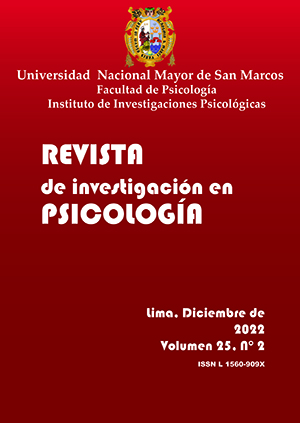Confirmatory factor analysis and factorial invariance of the APGAR-family scale in older adults in Lima
DOI:
https://doi.org/10.15381/rinvp.v25i2.22864Keywords:
APGAR, family, older adults, psychometric evidenceAbstract
Background: Family functioning is an important factor in mental health, particularly in vulnerable populations such as the elderly. Therefore, it is necessary to have valid, reliable, and equitable measurement instruments for its adequate use in psychological assessment and intervention. Objective: To analyze the evidence of validity, reliability and equity of the Family Functionality Scale (APGAR) in a sample of Peruvian older adults. Methods: A total of 522 older adults, aged 60 to 93 years (M=70.81, SD=7.62), responded to the APGAR scale. Results: Adequate fit indices were found for a three-factor correlated model: x2/gl=1.61, CFI=.99, TLI=.98, SRMR=.05, and RMSEA=.04. A relationship was also found between the APGAR scores and the WHO-5 (r=.318), which is evidence of convergent validity. Likewise, evidence of reliability of the scores was found (>.80); finally, the scale is invariant with respect to sex CFI (∆CFI< .01) and RMSEA (∆RMSEA< .01) are lower .01. Conclusions: The APGAR test gathers evidence of validity, reliability and fairness for its correct use in Peruvian older adults.
Downloads
Published
Issue
Section
License
Copyright (c) 2022 Noemi E. Iparraguirre Yaurivilca, Fernando J. Rosario Quiroz, Milagros O. Oblea Durand

This work is licensed under a Creative Commons Attribution 4.0 International License.
THE AUTHORS RETAIN THEIR RIGHTS:
a. The authors retain their trademark and patent rights, and also on any process or procedure described in the article.
b. The authors retain the right to share, copy, distribute, execute and publicly communicate the article published in the Journal of Research in Psychology (for example, place it in an institutional repository or publish it in a book), with acknowledgment of its initial publication in the Journal of Research in Psychology.
c. Authors retain the right to make a subsequent publication of their work, to use the article or any part of it (for example: a compilation of their work, lecture notes, thesis, or for a book), provided that they indicate the source. of publication (authors of the work, magazine, volume, number and date).






